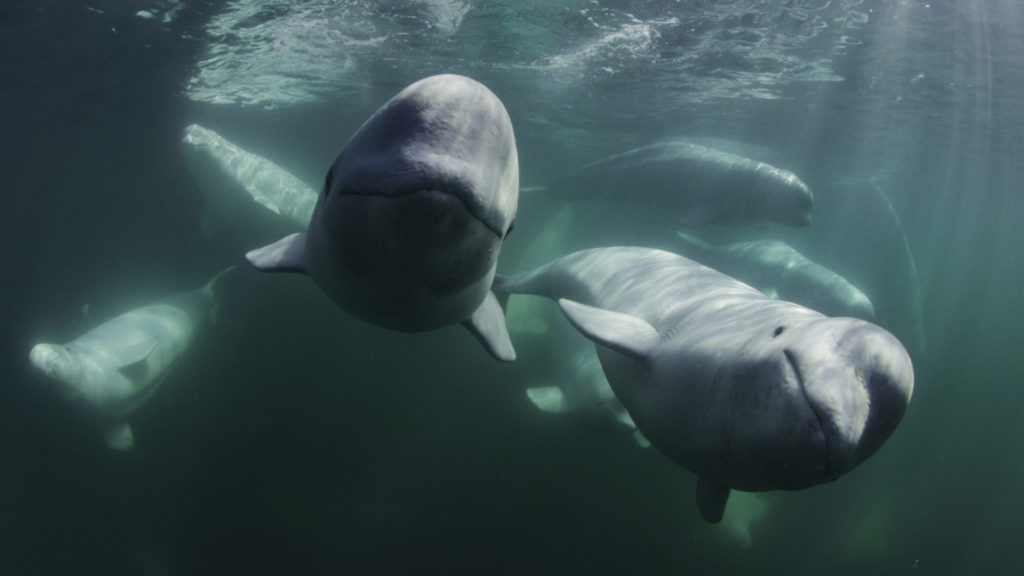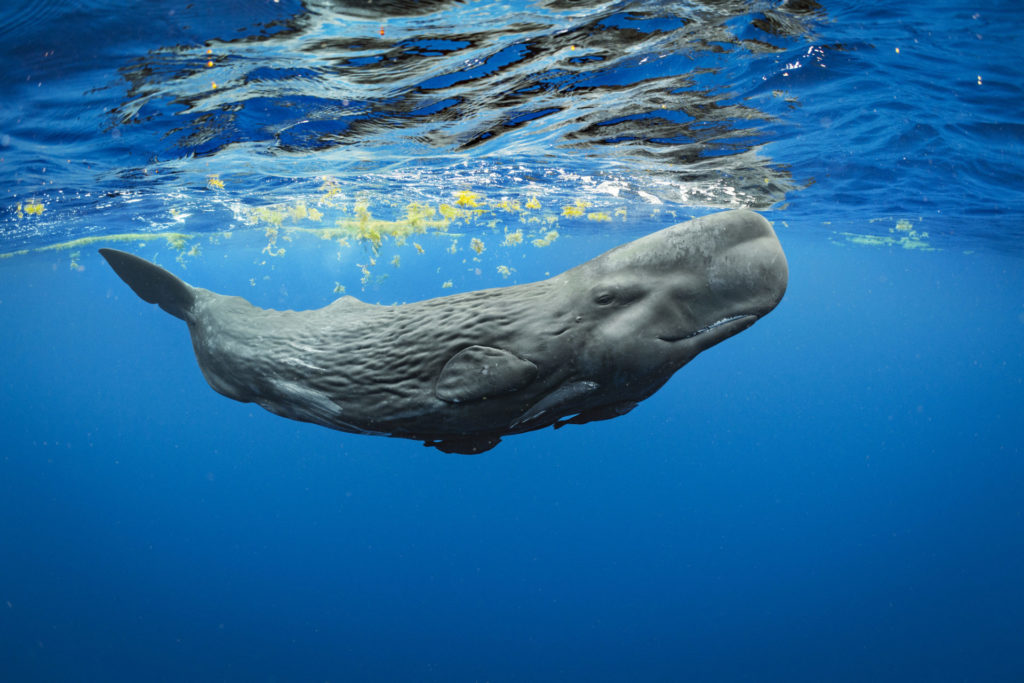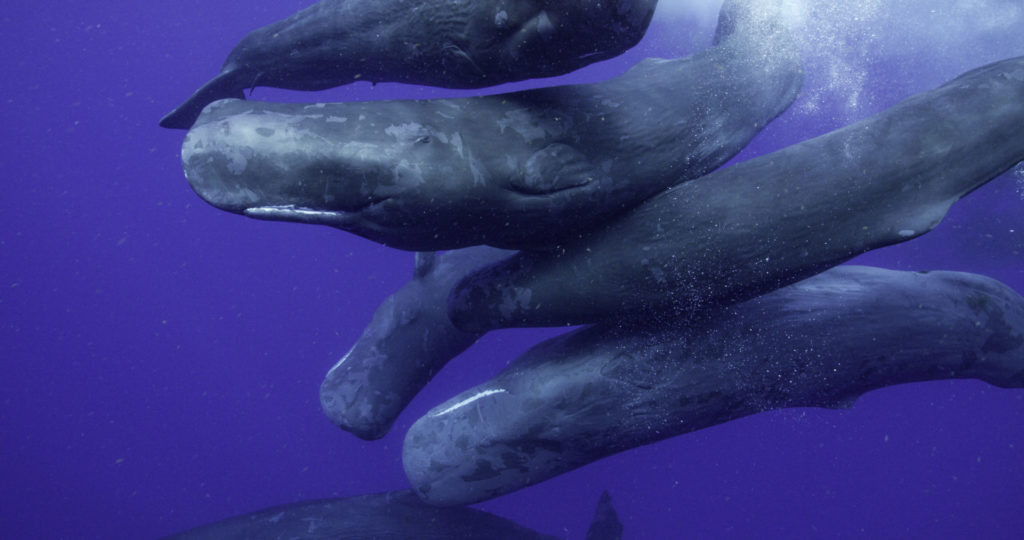“Divine intervention.” That’s how National Geographic Explorer and photographer Brian Skerry explains how he was able to capture some truly jaw-dropping moments for the new Disney+ documentary series and accompanying book Secrets of the Whales. How else can he explain having an orca swim right up to him and offer to share the stingray it just caught? Or being literally right next to a pod of humpback whales as they burst from the water during an elaborate feeding ritual? Or being the first person ever to witness a sperm whale calf nursing?
Of course, another explanation would be that Skerry is one of the world’s foremost underwater photographers, having spent more than 10,000 hours in the deep blue reporting on marine life. He captures those unbelievable moments because it’s his job—a job he has both loved and taken very seriously since he shot his first story for National Geographic magazine in 1998.

This project, he says, is his most important one yet. In 2017, he pitched the magazine a story on how whales have culture, but after getting the green light he realized the piece would be bigger than he’d anticipated. Soon, he had a three-year fellowship with the National Geographic Society, along with deals to produce a documentary series and a book. “I felt that there was an opportunity, without overtly being about conservation, to get people to care about the ocean,” Skerry says on a February morning, calling from his home in York, Maine. “If they could see the ocean through the lens of culture, through these families of whales with personality and history and things that matter to them, then maybe we might see our planet in a new way. It’s a bit of a game-changer, really.”
Through the four-episode series, which premieres April 22 and is narrated by Sigourney Weaver and executive-produced by James Cameron, Skerry and a team of scientists prove that whales—much like the celebrities in the pages of Us Weekly—are just like us. Skerry laughs at this comparison but agrees that it’s “so, so true.” After watching Secrets of the Whales, he says, “You can no longer go back to just thinking of them as big fish.”
Setting out to uncover these “secrets” was no small task. “The greatest day of my life was when this project got approved, but then it’s terrifying,” says Skerry, whose first whale encounter was in 1985, when he untangled a humpback calf from a lobster trap trawl line while on a shipwreck dive off Cape Cod. “You wake up the next day, and it’s like, ‘Oh my goodness, now I have to deliver.’ Because you just know how hard it is.”
As an underwater photographer, Skerry has to be in the water, of course, and if he’s free diving he can stay under only for as long as he can hold his breath—about two or three minutes. Unlike terrestrial photographers, he can’t use a telephoto lens, so he has to get within 10 or 15 feet of his subjects. As if the odds weren’t stacked against him enough, he points out one more factor: “The sun has to be out. I can’t light a whale.”

Skerry worked with scientists all over the world—New Zealand, the Cook Islands, the Canadian Arctic, Dominica, Antarctica, Alaska—who are studying everything from how humpbacks communicate (“like Amy Adams’s character in Arrival, trying to decipher this alien language”) to how orcas live in matriarchal societies. “I often describe my work by saying I sort of parachute into the lives of these researchers and try to tell their story visually,” he says. “I wouldn’t be able to do what I do if it weren’t for [them]. I can go out and just make pretty pictures, but if I’m trying to tell a story scientifically, [they’re] important.”
Skerry spent just days in some locations and months in others. He went to Dominica with researcher Shane Gero three times to document sperm whales. The first trip bore few results, and on the second visit Skerry spent his first 19 days there just waiting to see a whale. Gero stressed it was an anomaly, but for Skerry, who’s quite familiar with National Geographic’s number one rule—“we don’t publish excuses”—it was a bit terrifying. “On Day 19, you don’t know that on Day 20 you’re going to see a whale,” he says. “You’re so stressed.” On the third trip, he finally struck gold, when he managed to document a sperm whale nursing. (Until that moment, scientists had never been able to figure out how a calf could manoeuvre its lower jaw to nurse.) “Shane had said, ‘There’s an old saying in the whale biology world that someday we will know everything there is to know about whales except how a sperm whale nurses,’” Skerry recalls, with a laugh. “And now I got these pictures! That night, Shane was emailing the whole whale biology world.”

Milestone moments like these are no doubt rewarding, but Skerry—who grew up in Massachusetts “reading National Geographic magazine and watching those old Jacques Cousteau documentaries and dreaming of being an ocean explorer” is grateful for any and every moment he gets to spend communing with these animals. “A lot of times, when all you’re doing is looking through the viewfinder, you lose sight of the actual experience,” he says. “I’ve got to get the picture … but by the same token, when you have an hour with a baby whale that’s literally playing with you and swimming with you like a friend, at some point, yeah, I stop taking pictures and just soak it up a little bit.”
Skerry knows that most people’s experience with whales is very different from his. “There’s a multibillion-dollar whale-watching industry on planet Earth,” he says. “People go out on a boat and see a whale breach, and then they eat a hot dog and go home and think that was great. But they don’t know a lot about those animals’ lives. With Secrets of the Whales, that’s what we’re bringing them. I think animal culture will be revealed in bigger and better ways as we go forth—not only with whales, but with everything.”
Next Up: Philippe Cousteau Jr. On Leaving A Legacy Without Leaving A Trace
